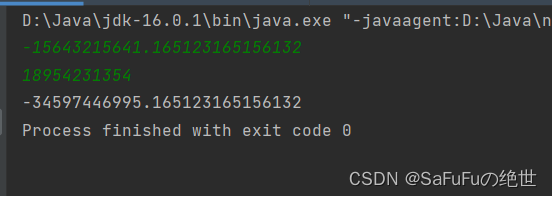题目
由于计算机中浮点数表示具有“不精确性”,无法用在要求精确运算(例如银行)的场景。如果将小数的整数部分和小数部分分别以字符串保存,并且在算术计算时分别计算整数和小数部分(并考虑小数向整数部分的进位),就可以实现精确的小数类。类的属性、方法设计可以参考Java的BigDecimal类。
立意
这是Java作业,原本是要利用字符串去做模拟,不过为了实现无穷大的精确小数类,并且躲开字符串的操作,我选择用易于增加的Int型的List来模拟。
碍于乘除部分实在复杂,我又比较懒,这个作业又是不那么大的作业,我就只写了加减法有兴趣可以根据类似加减法的方式写出乘除法。
讲解思路
暂时不讲,这两天比较忙,而且代码不是很复杂(应该),等我有空,或者有需求的话我再补(有空补大概是不可能,所有有问题就在下边问,我会补齐讲解然后回复你的)。
代码部分
package Matrix;
import java.util.ArrayList;
import java.util.List;
public class Exactdecimal {
private boolean minus=false;
private List<Integer> leftValue=new ArrayList<Integer>();
private List<Integer> rightValue=new ArrayList<Integer>();
private static int ten=10;
//构造函数
public Exactdecimal(String value)
{
int record=0;
String[] ipt=value.split("\\.");
char[]leftData =ipt[0].toCharArray();
if(leftData[0]=='-')
{
minus=true;
record=1;
}
for (int i=leftData.length-1;i>=record;i--)
{
var currentData= String.valueOf(leftData[i]);
leftValue.add(Integer.parseInt(currentData));
}
if(ipt.length>=2)
{
char[] rightData = ipt[1].toCharArray();
for (int i = 0; i < rightData.length; i++)
{
var currentData = String.valueOf(rightData[i]);
rightValue.add(Integer.parseInt(currentData));
}
}
}
//数加
private Exactdecimal NumAdd(Exactdecimal tmain, Exactdecimal other)
{
int i=0;
//TODO:位加
while (tmain.leftValue.size()>i||other.leftValue.size()>i)
{
if(tmain.leftValue.size()>i)
{
if(other.leftValue.size()>i)
tmain.leftValue.set(i,tmain.leftValue.get(i)+other.leftValue.get(i));
}
else tmain.leftValue.add(other.leftValue.get(i));
i++;
}
i=0;
while (tmain.rightValue.size()>i||other.rightValue.size()>i)
{
if(tmain.rightValue.size()>i)
{
if(other.rightValue.size()>i)
tmain.rightValue.set(i,tmain.rightValue.get(i)+other.rightValue.get(i));
}
else tmain.rightValue.add(other.rightValue.get(i));
i++;
}
//TODO:进位
for(i=tmain.rightValue.size()-1;i>=0;i--)
{
if(i!=0)
tmain.rightValue.set(i-1,(tmain.rightValue.get(i)/ten)+tmain.rightValue.get(i-1));
else
tmain.leftValue.set(0,(tmain.rightValue.get(i)/ten)+tmain.leftValue.get(0));
tmain.rightValue.set(i,tmain.rightValue.get(i)%ten);
}
for (i=0;i<tmain.leftValue.size();i++)
{
if(i+1<tmain.leftValue.size())
tmain.leftValue.set(i+1,(tmain.leftValue.get(i)/ten)+tmain.leftValue.get(i+1));
else
if((tmain.leftValue.get(i) / ten)>0)tmain.leftValue.add(tmain.leftValue.get(i)/ten);
tmain.leftValue.set(i,tmain.leftValue.get(i)%ten);
}
return this;
}
//数减
private Exactdecimal NumSubtract(Exactdecimal tmain,Exactdecimal other)//大数在前
{
//TODO:零的同步
while (true)
{
if(tmain.rightValue.size()>=other.rightValue.size())
break;
tmain.rightValue.add(0);
}
while (true)
{
if(tmain.rightValue.size()<=other.rightValue.size())
break;
other.rightValue.add(0);
}
//TODO:位减
for (int i=0;i<tmain.rightValue.size();i++)
{
tmain.rightValue.set(i,tmain.rightValue.get(i)-other.rightValue.get(i));
}
for (int i=0;i<tmain.leftValue.size();i++)
{
if(other.leftValue.size()-1>=i)
tmain.leftValue.set(i,tmain.leftValue.get(i)-other.leftValue.get(i));
}
//TODO:进位
for (int i=tmain.rightValue.size()-1;i>=0;i--)
{
if(tmain.rightValue.get(i)<0)
{
if(i==0)
{
tmain.leftValue.set(0,tmain.leftValue.get(0)-1);
tmain.rightValue.set(i,10+tmain.rightValue.get(i));
break;
}
tmain.rightValue.set(i-1,tmain.rightValue.get(i-1)-1);
tmain.rightValue.set(i,10+tmain.rightValue.get(i));
}
}
for (int i=0;i<tmain.leftValue.size();i++)
{
if(tmain.leftValue.get(i)<0)
{
tmain.leftValue.set(i + 1, tmain.leftValue.get(i + 1) - 1);
tmain.leftValue.set(i, 10 - tmain.leftValue.get(i));
}
}
//TODO:去零
int i=tmain.leftValue.size()-1;
if(i!=0)
{
while (tmain.leftValue.get(i)==0&&i!=0)
{
tmain.leftValue.remove(i);
i--;
}
}
return tmain;
}
//减法
public Exactdecimal Subtract(Exactdecimal other)
{
Exactdecimal resultofthis = null;
int state=ThisIsBigThenOther(other);
if (!this.minus && other.minus || !other.minus && this.minus)
{
resultofthis= NumAdd(this,other);
if(!other.minus)
resultofthis.minus = true;
}
else {
switch (state)
{
case 1:
resultofthis = NumSubtract(this,other);
break;
case -1:
resultofthis = NumSubtract(other,this);
resultofthis.minus=true;
break;
case 0:
resultofthis = new Exactdecimal("0.0");
break;
}
if(this.minus)
resultofthis.minus=!resultofthis.minus;;
}
return resultofthis;
}
//加法
public Exactdecimal Add(Exactdecimal other)
{
Exactdecimal resultofthis = null;
if (!this.minus && other.minus || !other.minus && this.minus)
{
int state=ThisIsBigThenOther(other);
switch (state)
{
case 1:
resultofthis = NumSubtract(this,other);
break;
case -1:
resultofthis = NumSubtract(other,this);
resultofthis.minus=true;
break;
case 0:
resultofthis = new Exactdecimal("0.0");
break;
}
if(this.minus)
resultofthis.minus=!resultofthis.minus;;
}
else {
resultofthis= NumAdd(this,other);
if(!other.minus)
resultofthis.minus = true;
}
return resultofthis;
}
//输出
public void ShowData()
{
if(this.minus==true)
System.out.print("-");
for (int i=leftValue.size()-1;i>=0;i--)
{
System.out.print(leftValue.get(i));
}
System.out.print(".");
for (int i=0;i<rightValue.size();i++)
{
System.out.print(rightValue.get(i));
}
}
//当前数是否大于另一个
private int ThisIsBigThenOther(Exactdecimal other)
{
if(this.leftValue.size()>other.leftValue.size())
{
return 1;
}else if(this.leftValue.size()<other.leftValue.size())
{
return -1;
}
for (int i=this.leftValue.size()-1;i>=0;i--)
{
if(this.leftValue.get(i)>other.leftValue.get(i))
{
return 1;
}
else if(this.leftValue.get(i)<other.leftValue.get(i))
{
return -1;
}
}
if(this.rightValue.size()>other.rightValue.size())
{
return 1;
}else if(this.rightValue.size()<other.rightValue.size())
{
return -1;
}else
{
for(int i=0;i<this.rightValue.size();i++)
{
if(this.rightValue.get(i)>other.rightValue.get(i))
{
return 1;
}
else if(this.rightValue.get(i)<other.rightValue.get(i))
{
return -1;
}
}
return 0;
}
}
public static String reverseTestOne(String s)
{
return new StringBuffer(s).reverse().toString();
}
}
效果
